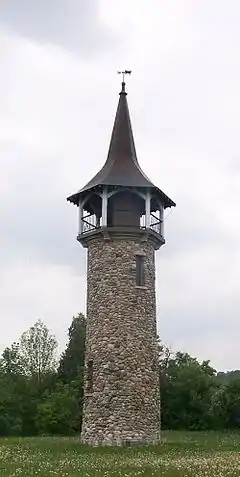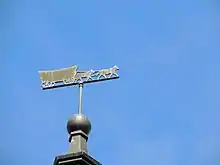Waterloo Pioneer Memorial Tower
The Waterloo Pioneer Memorial Tower was built in 1926 in Kitchener to commemorate the arrival of the Pennsylvania Dutch to Southwestern Ontario. It was conceived by William Henry Breithaupt, who wanted to heal wounds of nationalism fomented in the city during World War I which led to increasing anti-German sentiment and an eventual change in the name of the city from Berlin to Kitchener.
| Waterloo Pioneer Memorial Tower | |
|---|---|
 | |

| |
| General information | |
| Type | Memorial tower |
| Town or city | Kitchener, Ontario |
| Country | Canada |
| Coordinates | 43.400142°N 80.416220°W |
| Inaugurated | 28 August 1916 |
| Owner | Parks Canada |
| Height | 18.9 metres (62 ft) |
| Technical details | |
| Material | Fieldstone |
| Design and construction | |
| Architect | William A. Langton |
The tower overlooks the Grand River on a site once cleared by the first pioneers to settle the area. Its walls consist of fieldstone, its observation deck references the Grand River Trail along which the pioneers travelled, and the roof is topped by a weather vane in the shape of a Conestoga wagon. For many years, it was depicted in the masthead of the local newspaper The Record.
Background
In the late 1700s and early 1800s, numerous Pennsylvania Dutch immigrated from New York and Pennsylvania to Ontario.[1] They settled in several areas, particularly York Region and the three cities of Cambridge, Kitchener, and Waterloo. Among the first of the immigrants were Samuel Betzner and Joseph Schörg,[note 1] who had travelled more than 700 kilometres (430 mi) over 10 weeks in a Conestoga wagon.[1] They arrived in the late 1700s from Franklin County, Pennsylvania, and established homesteads in Kitchener.[1][2]
By the early 20th century, the city of Berlin (now Kitchener) had become known as "the German Capital of Canada" for its many families of German descent living in the area.[3] The city had a German-language newspaper and schools taught German,[3] with 80% of elementary school students enrolled in optional German classes in 1911.[4] The city had a large manufacturing industry, whose products were stamped with "Made in Berlin, Canada".[5]
During World War I, increasing anti-German sentiment led to mistrust of people of German heritage.[5] The Berlin School Board terminated the teaching of German in its schools, and in 1916,[6] the Berlin Board of Trade suggested the city be renamed.[3] It cited a negative effect of the city's name on business,[5] and that making such a change would symbolize the patriotism of its residents.[3] Despite objections to the proposal, a referendum was scheduled for May 1916.[3]
Supporters of the name change had taken several actions to ensure its success, including having opponents declared aliens, and intimidation tactics to prevent organization of an opposition movement, to deter them from casting a ballot, and from sending sufficient scrutineers to the polls.[7] In the months leading up to the referendum, there was "violence, riots and intimidation, often instigated by imperialistic members" of the 118th (North Waterloo) Battalion of the Canadian Expeditionary Force.[3] In an address to the residents of the city, sergeant major Granville Poyser Blood of the 118th Battalion famously stated "Be British. Do you duty or be despised...Be British or be damned".[8] Blood, a "fearless and fearsome leader",[9] led members of the Battalion in a riot within the city, an act he defended by stating "I have been trained to destroy everything of military advantage to the enemy".[10] The referendum was supported by the majority of the city's residents.[3]

On 28 June 1916, a second referendum was held to choose the new name of the city, which the Berlin News Record described by stating that the "outstanding feature was the absolute indifference displayed by the ratepayers".[6] On 1 September 1916 the name was officially changed to Kitchener.[11]
History

On 13 July 1923, the Waterloo County Pioneers' Memorial Association was formed with the patronage of the Waterloo Historical Society,[12] and its board of directors included its members and descendants of the first Mennonite families to move to the area.[2] The tower was conceived by William Henry Breithaupt,[13] president of the association,[12] who wanted to commemorate the Mennonites who had moved to the area (and also the first farmers of Waterloo Region), and to heal the wounds of earlier nationalism that led to the city's name change.[14] Breithaupt, according to local historian Rych Mills, "was trying to just re-jig our history a little tiny bit because of all the troubles we went through in World War One."[14] A group petitioned the council of the County of Wellington to build the tower.[15]
The Memorial Association purchased a 1.17 acres (4,700 m2) parcel of land that had been part of the Betzner property from Isaac Furtney in January 1924, and construction began in May 1925.[13] Its architect was William A. Langton of Toronto.[16] The cost of $4,500 (equivalent to $63,495 in 2016) was funded via subscription.[13]
The tower commemorates the settlement by the Pennsylvania Dutch (actually Pennsilfaanisch Deitsch or German)[17] of the Grand River area in what later became Waterloo County, Ontario.[1] It was dedicated on 28 August 1926.[13][18]
Structure

The tower was built on a site once cleared by Betzner's son near what is now the Doon neighbourhood of Kitchener.[1] It stands on a ridge overlooking the Grand River, opposite a water treatment plant.[1] The 18.9-metre (62 ft) tapered tower is built of rounded fieldstone, which had been collected over time from the surrounding 200 acres (810,000 m2) of land.[15][19] It is topped by a weather vane shaped as a Conestoga wagon.[1] In 2009, the weather vane was restored, and the tapered copper roof was replaced.[1][20]
The weather vane and roof reflect the Swiss heritage of the early Pennsylvania Dutch settlers.[2] The design of the observation deck integrates references to true north, and the Grand River Trail along which the first immigrants travelled to settle the area.[2]
Legacy
For many years, the tower was included in the masthead[note 2] of The Record.[1] Archival documents regarding the tower's conception, construction, and dedication are stored at the Kitchener Public Library in collections MC.55 and MC.113.[13]
The site was acquired by the Historic Sites Branch of the Department of the Interior in 1939, owing to the Waterloo Historical Society lacking the reserve funds to finance its maintenance.[13] It is now owned by Parks Canada, and managed by the Woodside National Historic Site.[21] The site is open to the public, but since 2008 the tower is opened only by request.[1]
Notes
- Schörg's name is also recorded as Schoerg and Sherk.
- Also known as a nameplate.
Citations
- Thompson 2015.
- Parks Canada: Waterloo Pioneers Memorial Tower.
- Collections Canada 2000.
- Coschi 2014, p. 316.
- CBC News 2016.
- D'Amato 2014.
- Coschi 2014, p. 317.
- Coschi 2014, p. 311.
- Mantle 2007, p. 258, End note 113.
- Mantle 2007, p. 200.
- Outhit 2016.
- Uttley 2010, p. 391.
- Kitchener Public Library: MC.113.
- Snell 2016.
- Beattie 2016.
- Pohlsander 2010, p. 14, Footnote 47.
- Elliot 1988, p. 105.
- Canadian Register of Historic Places.
- Pohlsander 2010, p. 14.
- Parks Canada: Site management.
References
- Beattie, Samantha (23 November 2016). "The push for Waterloo Region's Pioneer Tower". Waterloo Chronicle. Retrieved 29 January 2017.CS1 maint: ref=harv (link)
- Coschi, Mario Nathan (June 2014). ""Be British or be d–d": Primary education in Berlin-Kitchener, Ontario, during the First World War". 47 (94journal=Social History). Retrieved 30 January 2017. Cite journal requires
|journal=(help)CS1 maint: ref=harv (link) - D'Amato, Luisa (28 June 2014). "First World War ripped away Canada's 'age of innocence'". Waterloo Region Record. Retrieved 30 January 2017.CS1 maint: ref=harv (link)
- Elliot, Robbins (1988). Ontario Book of Days. Dundurn Press. ISBN 1550020331.CS1 maint: ref=harv (link)
- Mantle, Craig, ed. (2007). The Apathetic and the Defiant: Case Studies of Canadian Mutiny and Disobedience, 1812 to 1919. Dundurn Press. ISBN 9781550027105.CS1 maint: ref=harv (link)
- Outhit, john (27 June 2016). "June 28, 1916: Exactly 346 people voted for Berlin to be renamed Kitchener". Waterloo Region Record. Retrieved 29 January 2017.CS1 maint: ref=harv (link)
- Pohlsander, Hans A. (2010). German Monuments in the Americas: Bonds Across the Atlantic. New German-American studies. 33. Peter Lang. ISBN 9783034301381. ISSN 1043-5808.CS1 maint: ref=harv (link)
- Snell, Laurie (13 April 2016). "Closing off the past". Kitchener Post. Retrieved 29 January 2017.CS1 maint: ref=harv (link)
- Thompson, Catherine (15 March 2015). "Descendant of Waterloo pioneers wants memorial tower open again". Waterloo Region Record. Retrieved 29 January 2015.CS1 maint: ref=harv (link)
- Uttley, William Velores (Ben) (2010) [1937]. A History of Kitchener, Ontario. Wilfrid Laurier University Press. ISBN 9781554588084.CS1 maint: ref=harv (link)
- "Waterloo Pioneer Memorial Tower". Canadian Register of Historic Places, Parks Canada. Retrieved 29 January 2017.
- "Kitchener mayor notes 100th year of name change". CBC News. 1 September 2016. Retrieved 29 January 2017.
- "What's In a Name? Berlin to Kitchener". Canada and the First World War. Collections Canada, Library and Archives Canada. 11 November 2000. Retrieved 29 January 2017.
- "Waterloo Pioneer Memorial Tower: MC.113" (PDF). Kitchener Public Library. Item barcode 39098022000730. Cite journal requires
|journal=(help) - "Waterloo Pioneers Memorial Tower: Site management". Parks Canada. 10 March 2015. Archived from the original on 2016-12-13. Retrieved 29 January 2017.
- "Natural Wonders & Cultural Treasures: Waterloo Pioneers Memorial Tower". Parks Canada. 10 March 2015. Archived from the original on 2017-02-14. Retrieved 29 January 2017.
